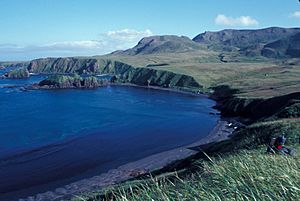Hawadax Island facts for kids
Hawadax Island is a small island located in the western Aleutian Islands in Alaska, USA. It's part of a group of islands called the Rat Islands. Until May 2012, this island was known as Rat Island. Its new name, Hawadax, comes from the Aleut language and means "entry" or "welcome." The island is about 10.72 square miles (27.8 km2) in size and no one lives there permanently. It is also part of the Alaska Maritime National Wildlife Refuge, which protects wildlife.
Contents
Why Was It Called Rat Island?
The name "Rat Island" was given to this group of islands by Captain Fyodor Petrovich Litke in 1827. He was exploring the world and visited the Aleutian Islands. The name was simply an English translation of what he called them.
Earthquakes in the Rat Islands
The Rat Islands, including Hawadax Island, are in an area where earthquakes happen often. This is because they sit on the boundary between two huge pieces of the Earth's crust, called tectonic plates: the Pacific Plate and the North American Plate. These plates are always moving, and when they rub against each other, it causes earthquakes. In 1965, a very strong earthquake, with a magnitude of 8.7, hit the Rat Islands.
Protecting Hawadax Island's Wildlife
Hawadax Island used to have a big problem with brown rats. These rats are an invasive species, meaning they are not native to the island and cause harm to the local environment. They were especially bad for ground-nesting wild birds, whose eggs and chicks were easy targets for the rats.
How Rats Arrived and Caused Problems
The rats first arrived on the island before 1780, likely from a Japanese shipwreck. Once they were there, they had a terrible effect on the local seabirds. These birds had no natural ways to defend themselves against the rats, as they had never encountered such predators before. Invasive rats are also found on 16 other islands in the Aleutian chain, causing similar problems.
Making the Island Rat-Free
In 2007, the U.S. Fish and Wildlife Service (FWS), which manages the wildlife refuge, started making plans to get rid of the rats. Their plan was based on a successful project that removed Arctic foxes from other Aleutian islands. Foxes had been brought to those islands on purpose for fur farming, but they also harmed bird populations.
In September 2008, the FWS worked with two groups, Island Conservation and The Nature Conservancy, to remove the Norway rats. They did this by dropping special bait from the air. This was the first time this method was used in Alaska.
Challenges and Successes
While the main goal was to remove rats, some other animals, like birds, were accidentally affected by the bait. More than 420 birds died, including 46 bald eagles and 320 glaucous-winged gulls. Tests showed that the bait caused these deaths. However, most bird populations that were studied actually grew larger after the rats were gone. This means that the negative effects on other animals were likely only for a short time.
In June 2009, Hawadax Island was officially declared rat-free for the first time in 229 years! The island was watched for two more years to make sure the rats were truly gone. Even though there were some challenges, the project was a big success for conservation. The manager of the Alaska Maritime National Wildlife Refuge said that it was a "learning experience" but also a "rip-roaring conservation success." After the rats were removed, monitoring showed a strong positive increase in bird populations and the health of the coastal areas.
See also
- Campbell Island, New Zealand, which also had a very successful rat eradication project.


